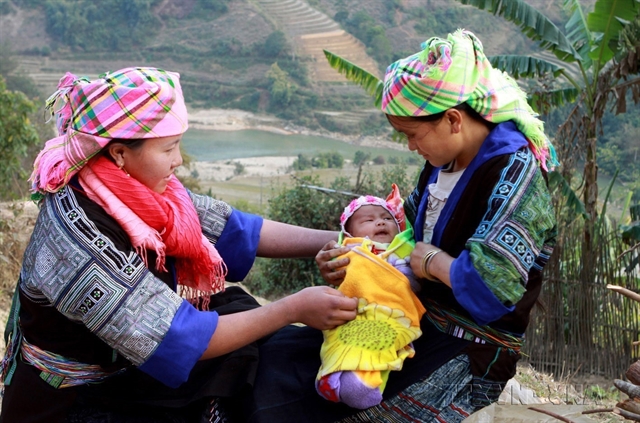 Society
Society

 |
| After more than 30 years of development, the network of “Village Midwives” now has thousands of ethnic minorities, trained to disseminate, advocate and provide safe services in villages and hamlets, thus contributing to reducing the mortality rate of mothers and newborns in remote areas. VNA/VNS Photo |
HÀ NỘI - The cause of reproductive health care and health care for mothers and children - who are vulnerable but play a decisive role in the country's future development - has gained many important achievements, which have been recognised and acknowledged by the international community. This is important evidence of efforts to ensure and promote human rights in Việt Nam.
Changing perception
It took only about 10 minutes for Giang A Lùng, a 21-year-old Mông ethnic minority in Mù Sang Commune, Phong Thổ District, the northern mountainous province of Lai Châu, to take his wife, Lý Thi So, to the commune medical station for periodical pregnancy examination. Accompanying the couple was their over-1-year-old son whom So gave birth to at this health station. Thanks to the advice and encouragement of local midwives, the couple have put their trust in reproductive health care services for mothers and children under 5 years old right in their residential areas, instead of caring for themselves and giving birth at home. In the past, this misconception was the cause of many tragic deaths of pregnant women and new-borns, affecting the health and quality of the population.
“We were encouraged by village midwives to go for prenatal check-ups and give birth at the commune health station. We gave birth to our first child at the health station and the baby is now healthy, so I continued to take my wife to it for prenatal check-ups for our second child. I am very grateful to the nurses and doctors of the health station and the village midwives," Lùng shared.
At this medical station in Mù Sang - a mountainous and remote border commune located more than 60km northwest of Lai Châu City, it is easy to meet many couples like Lung and So who come to use safe reproductive health services.
Physician Đào Hồng Nhật, head of the medical station, said that the station has seven medical staffs, including one doctor. All people in the commune have health insurance. The commune has 10 hamlets, with the furthest being about 15km from the station. Mù Sang also has two village-based midwives, and each hamlet has its own medical workers.
Considered an extended arm of the health sector, the village midwife network has been expanded across ethnic-inhabited and mountainous areas of the northern provinces of Lai Châu, Bắc Kạn, Sơn La and the Central Highlands provinces of Đắk Nông, Kon Tum and Gia Lai in recent years, thanks to the attention and support of the Ministry of Health, local administrations as well as the international community, including the project “Leaving no one behind: Innovative interventions to reduce maternal mortality in ethnic minority regions in Việt Nam” by the United Nations Population Fund (UNFPA) and partners. This model has been contributing to changing the awareness of people in these areas on reproductive health care and protection of mothers and children.
Talking numbers
The efforts of the health sector and partners have helped reduce maternal morbidity and mortality rates in mountainous and ethnic minority areas of Lai Châu in particular and Việt Nam at large.
In Mù Sang, while only about 44 per cent of pregnant mothers came for pregnancy check-ups at the station three times in 2021, this rate increased to more than 80 per cent at the end of 2023. The proportion of women receiving four prenatal check-ups rose from 37 per cent to nearly 71 per cent.
Doctor Dương Văn Quân, head of Phong Thổ District's medical centre, said that in 2022, only 48 per cent of women in the district received prenatal check-ups three times during pregnancy. However, the figure increased to nearly 62 per cent in the first quarter of 2024. Meanwhile, the proportion of women receiving four prenatal check-ups climbed from 29.3 per cent in 2022 to nearly 53 per cent in the first quarter of this year.
In the entire Lai Châuu Province, maternal and child health care and family planning, especially maternal health care before, during and after birth, in recent years have achieved or exceeded assigned targets. Notably, the number of women receiving prenatal check-ups at least three times surpasses 70 per cent, the rate of women and new-borns receiving care at home within 42 days after giving birth reaches more than 80 per cent, and the rate of children from 6 to 60 months old receiving Vitamin A in 2023 reached 98.9 per cent.
According to statistics from the health sector, Việt Nam has gained a lot of important achievements. The maternal mortality rate decreased by over five times, from 233/100,000 live births in 1990 to 44/100,000 live births in 2023. During this period, the mortality rate among children under 5 years old fell nearly 4 times, from 58 per thousand to 18.2 per thousand; and that among children under 1 year old from 44 per thousand to 11.6 per thousand. In addition, the child malnutrition rate also decreased sharply from 53 per thousand to 11 per thousand.
Impressed by the above convincing figures, Matt Jackson, UNFPA Representative in Việt Nam,said that Việt Nam is one of the countries with many achievements in the field of reducing maternal mortality, is listed among six countries in the world to achieve the standard of reducing this rate according to the previous millennium development goals.
He cited a 2022 study by the Vietnamese Ministry of Health as saying that the maternal mortality rate over the past 30 years has been reduced by up to 70 per cent, which is higher than the global figure of only 40 per cent. This is a very impressive rate, Jackson affirmed.
Stronger efforts needed
However, Việt Nam still faces many challenges ahead. According to the UNFPA Chief Representative in Việt Nam,survey data and statistics show maternal and child mortality and child malnutrition rates in mountainous areas are still 2-3 times higher than the national average. Many communal health stations have met national standards but lack equipment and have uneven human resources.
He recommended Việt Nam should increase investment in the village midwife network and have appropriate remuneration to retain them in the network.
Deputy Minister of Health Tran Van Thuan said that to continue to maintain and promote achievements in maternal and child health care, the health sector needs to make more efforts to well implement the Party and Government's Resolutions on strengthening the protection, care and improvement of people's health, and continue to improve the quality of operations of grassroots healthcare in the new situation.
The health sector must step up training and technology transfer, especially from upper to lower levels, with priority given to remote areas, Thuan said, stressing the need for appropriate salary and support policies for medical workers in remote areas.
The concerted implementation of these above solutions will create conditions to promote grassroots health coverage and improve the maternal and child health care network to gradually narrow the gap between mountainous and plain areas, and between urban and rural and remote areas, added the official. VNS




